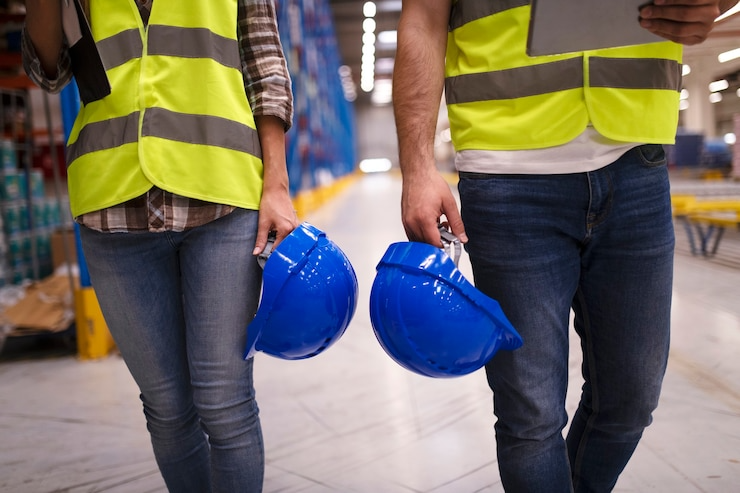Ensuring a safe and healthy workplace is not just a legal requirement — it’s a moral responsibility. This is where health and safety representatives come in. They are the backbone of a strong safety culture in any organisation, from factories and offices to construction sites and schools.
In this guide, we’ll break down exactly what health and safety representatives do, why they matter, and how their actions protect people every single day.
If you are someone considering a career in workplace safety or want to boost your understanding, taking up training like a NEBOSH Course in Multan can make a huge difference in developing practical skills.
Why Do Workplaces Need Health and Safety Representatives?
Picture this: a busy warehouse with forklifts buzzing around, heavy boxes stacked to the ceiling, and workers moving quickly to meet deadlines. Now imagine if no one was checking that safety measures were followed or that hazards were identified and controlled. Accidents would be waiting to happen.
Health and safety representatives help prevent such scenarios. They act as the link between management and employees, making sure everyone is aware of risks and how to tackle them.
Who Can Be a Health and Safety Representative?
In most organisations, these representatives are ordinary employees who volunteer or get elected by their co-workers. They don’t need to be supervisors or managers. What matters is that they care about their colleagues’ well-being and are willing to learn about workplace hazards.
A good representative is approachable, observant, and committed to speaking up when things aren’t right.
Key Responsibilities Explained Step-by-Step
Let’s dive into the core duties that health and safety representatives handle daily.
1. Identifying Hazards in the Workplace
This is their number one task. Hazards can be anything from a wet floor that could cause slips to faulty wiring that might start a fire. Representatives walk around the work area, watch how tasks are done, and talk to workers to spot risks.
Anecdote: Ahmed, a new representative in a textile mill, once noticed a small leak near a sewing machine. He reported it immediately. A day later, a colleague thanked him — if it hadn’t been fixed, the leak might have caused an electric shock. Small actions can prevent big disasters.
2. Carrying Out Workplace Inspections
Routine inspections help keep safety standards high. Representatives plan regular walk-throughs with checklists covering equipment, emergency exits, first aid supplies, and personal protective gear.
During these inspections, they may take photos, note down hazards, and recommend practical solutions. This proactive approach ensures hazards are tackled before they turn into accidents.
3. Communicating with Workers
One of the most important skills is good communication. Representatives must explain safety rules in clear, simple language and listen to any concerns employees raise.
For example, if workers complain about poor lighting in a stairwell, the representative must convey this to management and follow up until it’s fixed.
4. Consulting with Management
Representatives don’t work alone. They regularly meet with supervisors and managers to discuss safety reports and suggest improvements. Sometimes, they may be part of safety committees that review incidents and update policies.
Through open dialogue, they help build trust and encourage management to invest in better protective equipment or safer procedures.
5. Investigating Accidents and Near Misses
Despite everyone’s best efforts, incidents can still happen. When they do, representatives help investigate what went wrong. They gather facts, talk to witnesses, and help identify the root cause.
For instance, if a worker slips and falls, the representative might find that a leaking pipe caused the floor to be wet. Fixing the pipe and improving signage can stop it from happening again.
6. Encouraging Safe Work Practices
Representatives lead by example. They wear their protective gear properly, follow safe methods, and remind others to do the same. This influence helps create a safety-first mindset throughout the team.
They might also organise short safety talks, known as toolbox talks, to keep everyone updated on hazards and best practices.
7. Providing Training and Information
While they aren’t trainers by profession, representatives often share information about new safety measures. They may also help arrange formal training sessions for their teams.
For deeper expertise, many representatives enroll in recognised safety training. Enrolling in a NEBOSH Course in Multan can build the technical know-how needed to handle more complex hazards confidently.
8. Keeping Records
Documentation is crucial. Representatives maintain records of inspections, hazards found, incidents reported, and actions taken. These logs help track improvements and provide evidence if authorities inspect the workplace.
Accurate records also highlight recurring issues, guiding management where to invest resources for maximum safety impact.
9. Promoting a Positive Safety Culture
Beyond rules and checklists, representatives shape the workplace culture. They encourage workers to report unsafe conditions without fear and reward safe behaviours. A culture where safety is everyone’s business reduces accidents significantly.
10. Staying Updated
Regulations and best practices evolve. A dedicated representative stays up to date with industry standards, new protective equipment, or changes in safety laws.
Attending refresher courses, reading safety bulletins, or joining webinars helps them stay sharp and effective in their role.
Step-by-Step: How to Be an Effective Representative
Being effective goes beyond knowing responsibilities. Here’s a simple guide for anyone stepping into this role:
Step 1: Get Proper Training
A good foundation starts with knowledge. Consider enrolling in structured programs like the NEBOSH IGC Course to understand international standards and risk management.
Step 2: Know Your Workplace
Spend time on the floor. Talk to different teams, observe work processes, and ask questions. Familiarity helps spot hidden hazards.
Step 3: Build Trust
Be approachable and fair. Workers should feel comfortable bringing issues to you, knowing you’ll handle them professionally.
Step 4: Be Proactive
Don’t wait for something to go wrong. If you see a small hazard, fix it or report it immediately.
Step 5: Communicate Well
Use clear, simple words. Avoid jargon that confuses people. Listen actively and follow up on concerns.
Step 6: Keep Learning
The more you know, the more valuable you become. Attend seminars, read safety newsletters, and share knowledge with your team.
Challenges Representatives May Face
Being a health and safety representative isn’t always easy. Sometimes, they face resistance from co-workers who think safety slows down work. Or they may struggle to convince management to invest in better safety measures.
However, perseverance pays off. A safer workplace means fewer injuries, higher morale, and lower costs from accidents and lost productivity.
Anecdote: In one small factory, the health and safety representative fought hard to get new ventilation installed because workers were suffering from fumes. Initially, management hesitated due to costs. But after the installation, productivity improved because workers felt healthier and took fewer sick days. It was a win-win.
How Organisations Can Support Representatives
To get the best from their safety reps, employers should:
- Provide time during work hours for safety duties.
- Offer regular training and refresher programs.
- Supply necessary tools and protective gear.
- Encourage open communication and feedback.
Supportive management transforms safety reps from paper-pushers to powerful agents of change.
Why You Should Consider Safety Training
If you’re serious about becoming a health and safety representative or want to expand your knowledge, consider professional training.
Courses like the NEBOSH Course in Multan cover everything from hazard identification to risk control and accident investigation. They build confidence to handle real-life situations.
Read more: Learn how enrolling in a NEBOSH IGC Course can help you safeguard your team and create a safer workplace.
Conclusion
Health and safety representatives play a vital role in keeping workplaces free from harm. From spotting hazards to training colleagues and talking to management, their responsibilities shape a culture where safety comes first.
Their dedication saves lives, reduces costs, and keeps businesses running smoothly. If you’ve ever thought about stepping up to this rewarding role, don’t hesitate. Equip yourself with the right knowledge, build trust with your team, and lead the charge for a safer tomorrow.
Whether you work in an office, on a construction site, or in a factory, remember — safety doesn’t happen by accident. It happens because people like you care enough to make it a priority.











Leave a Reply